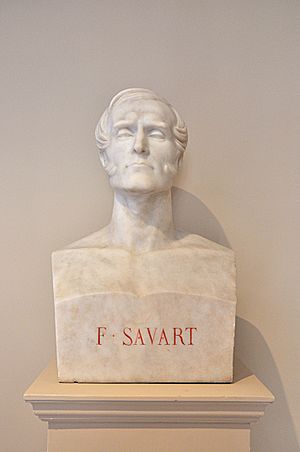Félix Savart facts for kids
Quick facts for kids
Félix Savart
|
|
|---|---|

Bust of Félix Savart in the Institut de France located in the 6th arrondissement of Paris
|
|
| Born | 30 June 1791 Charleville-Mézières, France
|
| Died | 16 March 1841 (aged 49) Paris, France
|
| Nationality | French |
| Alma mater | École polytechnique University of Strasbourg |
| Known for | Savart Savart wheel Biot–Savart law |
| Awards | ForMemRS (1839) |
| Scientific career | |
| Fields | Acoustics Physics |
| Institutions | Collège de France |
Félix Savart (born June 30, 1791, died March 16, 1841) was a French scientist. He was a physicist and mathematician. Savart is best known for the Biot–Savart law, which he discovered with his friend Jean-Baptiste Biot. This law helps us understand how magnetism and electricity are connected.
Savart was also very interested in acoustics, which is the science of sound. He studied how things vibrate to make sound. He even designed a special violin! He also invented the Savart wheel, a cool device that makes sounds at different pitches. The "savart" is also a unit of measurement for musical sounds, named after him.
About His Life
Félix Savart was born in Mézières, France, on June 30, 1791. His father, Gérard Savart, was an engineer. Félix's brother, Nicolas, also studied vibrations.
Félix first studied medicine at a military hospital in Metz. He then went to the University of Strasbourg and became a doctor in 1816.
In 1820, Savart became a professor at the Collège de France. That same year, he worked with Jean-Baptiste Biot to discover the Biot–Savart law. This important law explains how magnetic fields are created by electrical currents. It's a key part of understanding electromagnetism.
His Work with Sound
Savart spent a lot of time studying acoustics, the science of sound. He was fascinated by how different objects vibrate to make sounds.
The Savart Wheel
One of his most famous inventions is the Savart wheel. This device has a spinning disc with many small teeth. When you hold a card against the spinning teeth, it makes a sound. By changing how fast the wheel spins, you can change the pitch of the sound. Savart used this wheel to study the range of human hearing. He wanted to know what sounds people could hear.
Musical Intervals
Savart also studied musical intervals, which are the distances between two musical notes. A unit of measurement for these intervals is called the savart. Even though it's named after him, another scientist named Joseph Sauveur actually invented it first.
Savart's work helped us understand more about sound, music, and how electricity and magnetism are linked.
See also
 In Spanish: Félix Savart para niños
In Spanish: Félix Savart para niños
- Fluid thread breakup
- Portevin–Le Chatelier effect
- Velocimetry
- Violin acoustics

